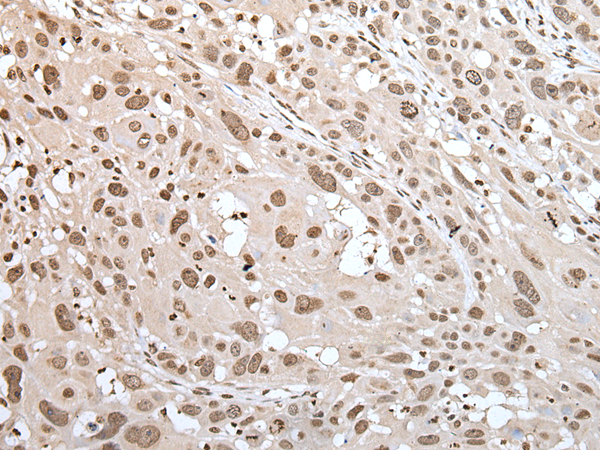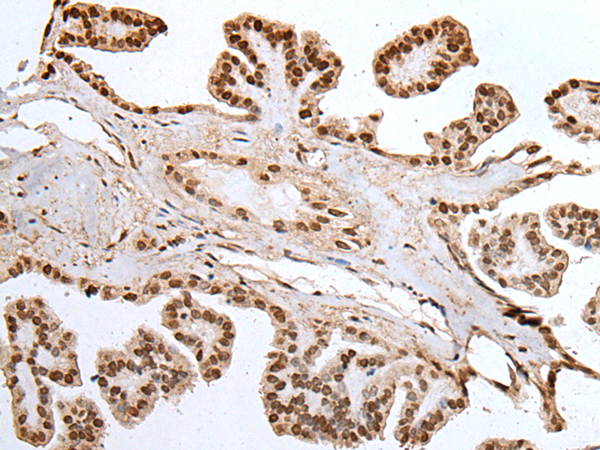

| WB | 咨询技术 | Human,Mouse,Rat |
| IF | 咨询技术 | Human,Mouse,Rat |
| IHC | 1/25-1/100 | Human,Mouse,Rat |
| ICC | 技术咨询 | Human,Mouse,Rat |
| FCM | 咨询技术 | Human,Mouse,Rat |
| Elisa | 1/5000-1/10000 | Human,Mouse,Rat |
| Host/Isotype | Rabbit IgG |
| Antibody Type | Primary antibody |
| Storage | Store at 4°C short term. Aliquot and store at -20°C long term. Avoid freeze/thaw cycles. |
| Species Reactivity | Human, Mouse, Rat |
| Immunogen | Synthetic peptide of human MEF2D |
| Formulation | Purified antibody in PBS with 0.05% sodium azide and 50% glycerol. |
+ +
以下是关于MEF2D抗体的3篇参考文献示例(文献信息为示例性概括,实际引用需核实原文):
---
1. **文献名称**:*MEF2D haploinsufficiency downregulates the NRF2 pathway and renders photoreceptors susceptible to light-induced oxidative stress*
**作者**:Okamoto S, et al.
**摘要**:研究MEF2D在视网膜光感受器细胞中的抗氧化保护作用,通过MEF2D抗体进行染色和Western blot分析,发现其调控NRF2通路缺陷导致光诱导氧化损伤。
2. **文献名称**:*MEF2D drives YAP-dependent transcriptional regulation of survival genes in acute myeloid leukemia*
**作者**:Flavahan WA, et al.
**摘要**:探讨MEF2D在急性髓系白血病中通过YAP信号通路促进癌细胞存活的机制,利用MEF2D抗体进行ChIP-seq和免疫共沉淀实验,揭示其作为潜在治疗靶点。
3. **文献名称**:*Developmental regulation of MEF2D phosphorylation and neuronal apoptosis*
**作者**:Mao Z, et al.
**摘要**:分析MEF2D磷酸化在神经元发育和凋亡中的作用,通过特异性抗体检测不同发育阶段的蛋白修饰,发现其磷酸化状态与神经元存活密切相关。
---
**提示**:实际引用时需通过学术数据库(如PubMed、Web of Science)检索最新文献,并核对作者、期刊及摘要准确性。
The MEF2D antibody is a crucial tool for studying the myocyte enhancer factor 2D (MEF2D) protein, a member of the MEF2 transcription factor family. MEF2D, encoded by the *MEF2D* gene, regulates gene expression by binding to specific DNA sequences via its conserved MADS-box and MEF2 domains. It plays pivotal roles in cellular processes such as muscle development, neuronal differentiation, and apoptosis. MEF2D is also implicated in oncogenesis, particularly in hematologic malignancies (e.g., acute leukemia with *RBM15-MEF2D* fusion) and solid tumors. Dysregulation of MEF2D has been linked to neurodegenerative disorders, including Alzheimer’s disease, where its activity influences synaptic plasticity and neuronal survival.
MEF2D antibodies are widely used in techniques like Western blotting, immunoprecipitation, chromatin immunoprecipitation (ChIP), and immunofluorescence to detect protein expression, localization, and DNA-binding interactions. These antibodies help elucidate MEF2D’s regulatory mechanisms, such as its post-translational modifications (e.g., phosphorylation, acetylation) and interactions with cofactors like histone deacetylases (HDACs). Commercially available MEF2D antibodies vary in host species (e.g., rabbit, mouse), clonality (monoclonal/polyclonal), and epitope specificity. Validation across species (human, mouse, rat) and applications ensures reliability in diverse experimental models. Researchers prioritize antibodies with high specificity and low cross-reactivity to avoid off-target effects, especially given MEF2D’s structural homology with other MEF2 family members (MEF2A/B/C). This antibody remains indispensable for dissecting MEF2D’s role in development, disease, and potential therapeutic targeting.
×